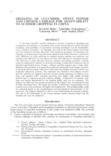Breeding of Cucumber, Sweet Pepper and Chinese Cabbage for Adaptability to Summer Cropping in China
Tropical agriculture research series : proceedings of a symposium on tropical agriculture researches
| ISSN | 03889386 |
|---|---|
| NII recode ID (NCID) | AA00870529 |

Full text
tars23-_134-146.pdf2.68 MB
To develop vegetable varieties adapted to summer cropping in Shanghai and Guangdong, performance of accessions and crosses among them in earlier and later croppings, and possibility of convenient screening techniques for the adaptability were examined. Cucumber : In Shanghai, the yield of the North Chinese accessions was less reduced in summer than that of the Japanese accessions. In Guanzhou, the Japanese accessions and crosses between Japanese and South Chinese F1s performed well. Difference in yield reduction in summer among varieties and locations was related to the difference in virus disease severity and reduction of vegetative growth. The difference in heat tolerance between summer and spring cucumber varieties could be estimated by analysis of electrolyte leakage or chlorophyll reduction rate of detached and heated leaves. Pepper : Chinese semi-hot peppers gave a high yield. Medium bell accessions were generally productive among the sweet pepper varieties. In the large bell accessions with fewer fruits, both the number and size of fruits were markedly reduced in summer. The reduction was related to virus disease severity and the reduction of vegetative growth. Crosses among Japanese or Chinese accessions and Japanese CMV resistant selections gave higher yield mainly through hybrid vigor in vegetative growth. Chinese cabbage : Productivity in summer cropping was largely determined by the heading ability and soft rot resistance. The former was observed only among accessions of the tropical type. Introductions from AVRDC performed best. The larger the number of distinctive characteristics of the tropical type in the accessions, the higher the heading rate. The heading ability could be estimated based on the morphological and physiological characteristics of the outer leaf. The highest resistance to soft rot was found among the autumn varieties. The size of the individuals in the crosses among varieties became larger but the heading rate was not enhanced.
| Date of issued | |
|---|---|
| Creator | Kenichi Hida Takehiko Nakashima Yangsong Shen Anjing Zhou |
| Publisher | Japan International Research Center for Agricultural Sciences |
| Volume | 23 |
| spage | 134 |
| epage | 146 |
| Language | eng |
